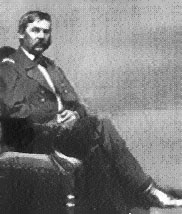| The Mounted Arm
|
|
The Forgotten Cavalry Battles of Summer 1863: (last updated 9/02) |
|
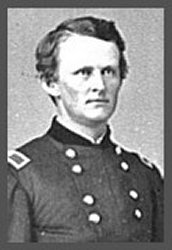 Brigadier General Wesley Merritt Commanding the Federal Reserve Cavalry Under newly-promoted Brigadier General Wesley Merritt, the Federal Reserve Cavalry Brigade of the Army of the Potomac was assigned to screen the left flank and rear of the Federals between Hagerstown and Frederick MD, and was therefore (like Stuart) not on the field during the Gettysburg battle's first two days. On the morning of July 3, however, a dispatch from Major General Alfred Pleasonton, commander of the Cavalry Corps, arrived at Merritt's Emmitsburg headquarters ordering him to move to Gettysburg and attack the Confederate right flank and rear. Merritt and Stuart would meet later that day at Hanover. While on the march toward Gettysburg, Merritt detached the 6th US Cavalry, under the command of Major Samuel Henry "Paddy" Starr, to ride to Fairfield, PA to seize a Confederate wagon train rumored to be foraging in the vicinity. The mission to Fairfield, about eight miles west of Gettysburg, would also put the 6th US in a position to cut off the Confederate line of retreat to the Potomac River. The mission entailed significant risk, however, as the 6th US would be operating well behind enemy lines and far beyond the support of the rest of the reserve brigade. Compounding the danger, the regiment was under-strength, having previously detached a squadron for duty with General Pleasonton's headquarters. |
|
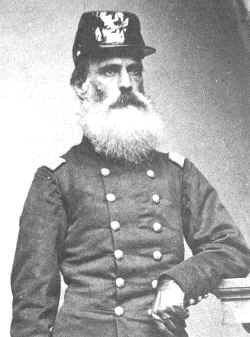 Major Samuel H. Starr: Commanding the 6th US Cavalry at Fairfield Major Starr, a legendary Dragoon, was the most experienced officer in the Reserve Brigade having served for more years than many of his superiors were old. A 31-year veteran, he had enlisted as a private in 1832 and risen through the ranks. At the outbreak of the Civil War, Starr was a captain in the 2nd Cavalry. He was appointed as a Colonel of Volunteers and commanded the 5th New Jersey Volunteer Infantry, leading them in the battles of Williamsburg and Fair Oaks. Starr resigned from the Volunteers, and was appointed Major of the 6th US Cavalry in the spring of 1863. For a time he commanded the entire Reserve Cavalry Brigade but was returned to command a single regiment when the young Merritt was promoted. Major Starr led his 400 troopers toward Fairfield without encountering any enemy resistance. South of the village he detached his 1st Squadron under Captain George Cram to follow a railroad bed and reconnoiter a wooded hillside to the west of the town, and screen the regiment's left flank as it moved north along the Fairfield-Orrtanna Road. No Confederate wagon train was found, but a few wagons had apparently left the town just as the regiment was arriving. Starr immediately sent a squadron under the command of Lieutenant Christian Balder in pursuit of what he thought was a small group of southern foragers. |
|
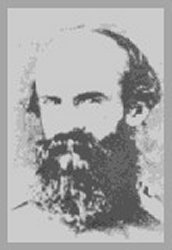 Brigadier General William "Grumble" Jones, CSA (1824-1864) A good fighter but considered cantankerous by his fellow officers. Charging after the retreating wagons, Balder's squadron ran head-long into a large column of approaching Confederate cavalry. This was the 7th Virginia Cavalry, the lead element of Confederate Brigadier General William E. "Grumble" Jones' brigade. Lt. Balder quickly wheeled his squadron around and raced back toward Fairfield to alert the rest of the regiment. Faced with a more numerous opponent Major Starr halted the 6th US Cavalry at the narrowest point in the valley and deployed his men. The topography was made for defense with stout post and rail fences lining the road, as well as an orchard on the left side and wheat fields on the right. Two squadrons of the 6th US dismounted and deployed along both sides of the road. Lieutenants Balder's and Bould's squadrons remained mounted in the roadway. Coming upon the mounted Federal, and without taking time to determine the strength of the Union position, Jones immediately ordered the 7th Virginia Cavalry to charge. The Confederate horsemen were met by a hail of carbine fire from both flanks. Caught in a crossfire, hemmed in by the fences and blocked from moving forward, the badly mauled 7th Virginia hastily retreated back down the road. Major Starr ordered his mounted companies into a charge to pursue the retreating Virginians and to continue to push them back. General Jones, however, seeing that he had a fight on his hands brought a horse artillery battery into action and countered with a charge of his own by the rest of his brigade. The pursuing squadrons of the 6th US collided with the 6th Virginia, the 11th Virginia, and reformed elements of the 7th Virginia in the fenced in roadway. The fight quickly turned into a brutal hand-to-hand brawl and the badly out-numbered Federals lost 242 troopers killed, wounded, or captured. As the charging forces collided, the 6th US Cavalry's standard bearer was shot. As the Confederates were about to seize the regiment's colors, Sergeant George C. Platt charged into the melee and rescued the standard. For his distinguished bravery, Platt was awarded the Medal of Honor. During the war, the 6th US Cavalry regiment lost 8 officers and 53 men killed in action, 122 wounded in action, and 438 captured or missing (most of these during the Fairfield, PA fight). |
|
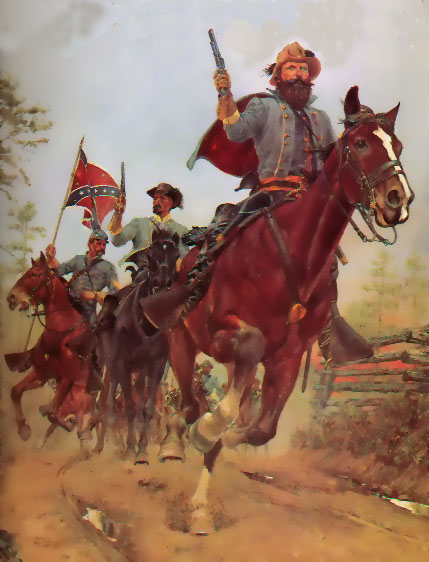 Confederate Cavalry Corps Commander James Ewell Brown Stuart (2) THE CAVALRY FIGHT AT UPPERVILLE, VIRGINIA |
|
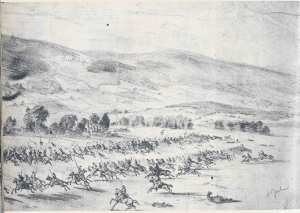 A Period Lithograph of the Battle of Upperville: June 21, 1863 Prelude to Gettysburg At the time of Gettysburg Alfred Pleasonton commanded the Federal Cavalry attached to the Army of the Potomac. In June 1863, Pleasonton's cavalry had surprised J. E. B. Stuart's men at Brandy Station, where Stuart's troops were massing to screen Robert E. Lee's Army of Northern Virginia as it headed north into Pennsylvania. After initially giving ground, Stuart's troops rallied and took back the field, making the contest a draw. However, Brandy Station was a 'moral' victory for the Union. For the first time the Federal cavalry proved to be the equal of the Confederate. As the Army of Northern Virginia made preparations to advance into the North. J.E.B. Stuart's cavalry corps was assigned the task of securing the passes in the Blue Ridge Mountains and masking the movement of Lee's Army. On June 21, Federal cavalry, buoyed by their recent success, made a determined effort to pierce Stuart's cavalry screen. Wade Hampton's and Beverley Robertson's Confederate brigades made a stand at Goose Creek, west of Middleburg, and beat back a Union Cavalry division under General J. I. Gregg. Brigadier General John Buford's cavalry column was ordered to attack the Confederate left flank near Upperville but encountered William E."Grumble" Jones and John R. Chambliss with their Confederate cavalry brigades. Meanwhile Gregg's brigade and that of Judson Kilpatrick advanced on Upperville from the east along the Little River Turnpike. After furious mounted fighting, Stuart withdrew his cavalry corps to take a strong defensive position in Ashby Gap, an important mountain pass. As cavalry skirmishing diminished the Army of Northern Virginia safely crossed the Potomac into Maryland. On its face the actions at Upperville were inconclusive, but because of them Stuart made the fateful decision to strike east and attempt a third circuit of the Union army as it marched toward Gettysburg. Stuart's absence on the first two days at Gettyburg is often cited as a cause for the southern defeat on the third day. Ironically, it was the presence of John Buford's Cavalry at Herr Ridge and their stubborn defensive retreat on the first day of Gettysburg that may have saved the "high ground" of Cemetery Ridge and the Round Top's for the Union. |
|
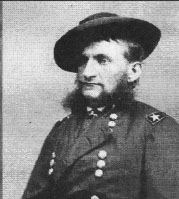 General Hugh Judson Kilpatrick |
|
